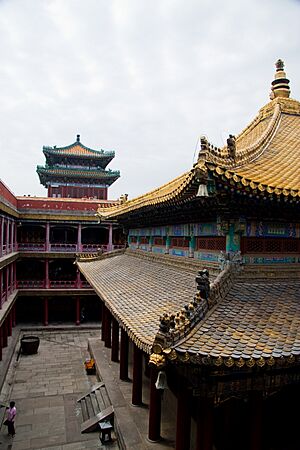Putuo Zongcheng Temple facts for kids
Quick facts for kids Putuo Zongcheng Temple |
|
|---|---|

The Putuo Zongcheng Temple of Chengde, built in the 18th century during the reign of the Qianlong Emperor.
|
|
| Religion | |
| Affiliation | Buddhist |
| Province | Hebei |
| Region | China |
| Status | Preserved |
| Location | |
| Municipality | Chengde |
| Architecture | |
| Architectural style | Tibetan and Chinese |
| Completed | 1771 |
| Putuo Zongcheng Temple | |||||||||
|---|---|---|---|---|---|---|---|---|---|
| Chinese name | |||||||||
| Simplified Chinese | 普陀宗乘之庙 | ||||||||
| Traditional Chinese | 普陀宗乘之廟 | ||||||||
|
|||||||||
| Alternative Chinese name | |||||||||
| Chinese | 小布达拉宫 | ||||||||
| Literal meaning | Little Potala Palace | ||||||||
|
|||||||||
| Tibetan name | |||||||||
| Tibetan | གྲུ་འཛིན་་་བསྟན་པའི་རྩ་བའི་ལྷ་ཁང༌། | ||||||||
|
|||||||||
The Putuo Zongcheng Temple is a large Buddhist temple complex in Chengde, Hebei province, China. Its name in Chinese is Chinese: 普陀宗乘之庙; pinyin: Pǔtuó Zōngchéng zhī miào. It was built a long time ago, between 1767 and 1771. This was during the time of the Qianlong Emperor, who ruled from 1735 to 1796.
The temple is located close to the Chengde Mountain Resort. It is one of the famous "Eight Outer Temples" of Chengde. This temple was designed to look like the Potala Palace in Tibet. The Potala Palace was the home of the Dalai Lama and was built about a hundred years earlier. Because of this, the Putuo Zongcheng Temple mixes both Chinese and Tibetan building styles.
This temple complex is very big. It covers an area of about 220,000 square meters (which is about 2.3 million square feet). This makes it one of the largest temples in China. Many of its buildings and towers have roofs covered with shiny copper and gold tiles. This makes the temple look very grand and beautiful.
History of the Temple
The Putuo Zongcheng Temple is part of a group called the "Eight Outer Temples" in Chengde. These temples, along with the Chengde Mountain Resort, are recognized as UNESCO World Heritage Sites. This means they are very important historical places.
These temples were managed by a special government department called the Lifan Yuan. This department handled matters for different groups of people, like Mongolians and Tibetans. That's why you can see a mix of building styles in these temples.
The Putuo Zongcheng Temple was built to celebrate the birthday of the Qianlong Emperor. It was also meant to be as grand and large as the Potala Palace in Lhasa. The temple was used for more than just Buddhist events. The emperor also held meetings there with leaders from different parts of his empire. It was a peaceful place for him to escape the busy capital city of Beijing. It was also near hunting grounds where the emperor enjoyed spending time with his guests.
In 1994, the Chengde Mountain Resort and the Eight Outer Temples, including the Putuo Zongcheng Temple, became World Heritage Sites. Today, many people visit the temple, and local festivals are still held there.
The Golden Temple Replica
In June 1930, a Swedish explorer named Sven Hedin visited the Putuo Zongcheng Temple. He was with Gösta Montell, Georg Söderbom, and a Chinese architect named Liang Weihua. Their goal was to get a Lamaistic temple for the World Exhibition in Chicago in 1933. This event was called "Century of Progress."
They made an exact, full-size copy of the temple's main hall in Beijing. They also made two smaller models, which were one-tenth the size. The full-size copy was set up in Chicago for the exhibition. One of the smaller models also went to Chicago to help with building the large one. The other small model was taken to the Museum of Ethnography in Stockholm, Sweden.
Temple Buildings and Features
The Putuo Zongcheng Temple has many interesting gates, halls, and towers.
See Also
- List of Buddhist temples
- Puning Temple
- Xumi Fushou Temple















